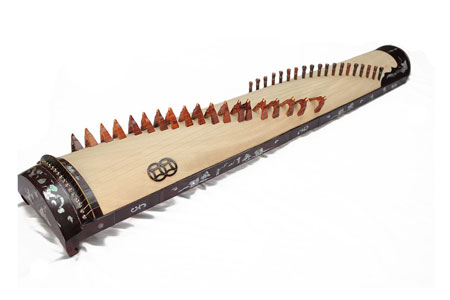The tranh zither is also called the thap luc cam or sixteen-stringed zither. The tranh zither appeared in Viet Nam in the time of the Tran dynasty (12th-13th centuries).

It has a rectangular sounding box, about 110cm long that tapers about 13cm toward an end, with a warped sound board made of unvarnished light wood. The sides are made of hard wood decorated with various designs, either lacquered or inlaid with mother-of-pearl. The bottom is made of light wood with sound holes. The broader end of the sound box is pierced with 16 holes and reinforced with a metal band.
Toward the middle of the sound board there are 16 bridges made of wood or bone tipped with copper that can be moved to vary the tension of the strings, thus creating various notes. At the narrower end of the box are sixteen pegs for tuning. The strings are metal and tuned to the pentatonic scale.
The range of the tranh zither is about three octaves, from the notes C to C3. The player uses a plectrum and can play chords, trills, tremolos... His left hand, which manipulates the strings, can use such techniques such as pressing, vibrato, glissando, etc.
The music of the tranh zither is usually light and full of cheerfulness. The instrument bears some likeness to the Japanese Koto, the Korean Ka Yagum, the Mongolian Jatac, the Chinese Zeng, and the Indonesian Kachap, which have 13, 12, 12, 13-16, 7-24 strings, respectively. It is nonetheless an original Vietnamese instrument with specific musical characteristics. It is used to accompany poetry recitals and is quite often part of an orchestra or a band playing chamber music, religious music, or accompanying cheo or cai luong drama.